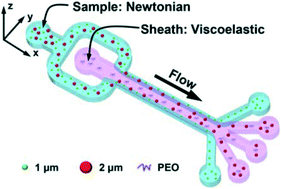Our official English website, www.x-mol.net, welcomes your
feedback! (Note: you will need to create a separate account there.)
Microfluidic co-flow of Newtonian and viscoelastic fluids for high-resolution separation of microparticles
Lab on a Chip ( IF 6.1 ) Pub Date : 2017-08-07 00:00:00 , DOI: 10.1039/c7lc00671c Fei Tian 1, 2, 3, 4, 5 , Wei Zhang 4, 5, 6, 7, 8 , Lili Cai 4, 9, 10, 11 , Shanshan Li 1, 2, 3, 4 , Guoqing Hu 4, 12, 13, 14, 15 , Yulong Cong 4, 9, 10, 11 , Chao Liu 4, 5, 6, 7, 8 , Tiejun Li 1, 2, 3, 4 , Jiashu Sun 4, 5, 6, 7, 8
Lab on a Chip ( IF 6.1 ) Pub Date : 2017-08-07 00:00:00 , DOI: 10.1039/c7lc00671c Fei Tian 1, 2, 3, 4, 5 , Wei Zhang 4, 5, 6, 7, 8 , Lili Cai 4, 9, 10, 11 , Shanshan Li 1, 2, 3, 4 , Guoqing Hu 4, 12, 13, 14, 15 , Yulong Cong 4, 9, 10, 11 , Chao Liu 4, 5, 6, 7, 8 , Tiejun Li 1, 2, 3, 4 , Jiashu Sun 4, 5, 6, 7, 8
Affiliation

|
The microfluidic passive control of microparticles largely relies on the hydrodynamic effects of the carrier media such as Newtonian fluids and viscoelastic fluids. Yet the viscoelastic/Newtonian interfacial effect has been scarcely investigated, especially for high-resolution particle separation. Here we report a microfluidic co-flow of Newtonian (water or PBS) and viscoelastic fluids (PEO) for the size-dependent separation of microparticles. The co-flow condition generates a stable viscoelastic/Newtonian interface, giving rise to the wall-directed elastic lift forces that compete with the center-directed lift forces, and efficiently hinders the migration of microparticles from the Newtonian to the viscoelastic fluid in a size-dependent manner. An almost complete separation of a binary mixture of 1 μm and 2 μm polystyrene particles is achieved by the co-flow of water and a very dilute PEO solution (100 ppm), whereas the sole use of water or PEO could not lead to an efficient separation. This co-flow microfluidic system is also applied for the separation of Staphylococcus aureus (1 μm) from platelets (2–3 μm) with >90% efficiencies and purities.
中文翻译:

牛顿流体和粘弹性流体的微流并流,用于微粒的高分辨率分离
微粒的微流体被动控制在很大程度上取决于诸如牛顿流体和粘弹性流体之类的载体介质的流体动力学效应。然而,几乎没有研究粘弹性/牛顿界面效应,特别是对于高分辨率颗粒分离。在这里,我们报告了牛顿(水或PBS)和粘弹性流体(PEO)的微流共同流动,用于微粒的尺寸依赖性分离。顺流条件产生稳定的粘弹性/牛顿界面,从而产生与中心定向的升力竞争的壁定向弹性升力,并有效地阻止了微粒从牛顿流向粘弹性流体的迁移。依赖的方式。水和非常稀的PEO溶液(100 ppm)的共流可实现1μm和2μm聚苯乙烯颗粒的二元混合物的几乎完全分离,而仅使用水或PEO不能有效分离。该同流微流体系统也适用于分离来自血小板(2-3μm)的金黄色葡萄球菌(1μm),效率和纯度均> 90%。
更新日期:2017-09-12
中文翻译:

牛顿流体和粘弹性流体的微流并流,用于微粒的高分辨率分离
微粒的微流体被动控制在很大程度上取决于诸如牛顿流体和粘弹性流体之类的载体介质的流体动力学效应。然而,几乎没有研究粘弹性/牛顿界面效应,特别是对于高分辨率颗粒分离。在这里,我们报告了牛顿(水或PBS)和粘弹性流体(PEO)的微流共同流动,用于微粒的尺寸依赖性分离。顺流条件产生稳定的粘弹性/牛顿界面,从而产生与中心定向的升力竞争的壁定向弹性升力,并有效地阻止了微粒从牛顿流向粘弹性流体的迁移。依赖的方式。水和非常稀的PEO溶液(100 ppm)的共流可实现1μm和2μm聚苯乙烯颗粒的二元混合物的几乎完全分离,而仅使用水或PEO不能有效分离。该同流微流体系统也适用于分离来自血小板(2-3μm)的金黄色葡萄球菌(1μm),效率和纯度均> 90%。











































 京公网安备 11010802027423号
京公网安备 11010802027423号